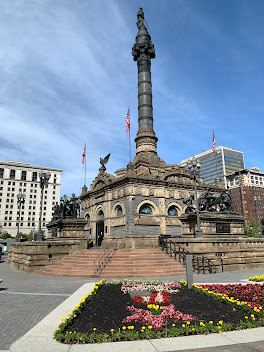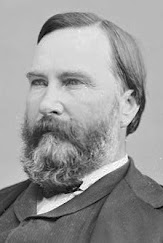 |
| Harvey's collar and Capt. D.M. Stearns (Courtesy Battle of Franklin Trust); replica statue of the dog at a Civil War memorial in Cleveland (Courtesy Soldiers' and Sailors' Monument) |
A red, white
and blue collar, festooned with military motifs and names of battle in which
the regiment fought, survives and is recreated in a bronze statue of the pup,
which is on display at The Battle of Franklin Trust’s Carter House in Tennessee.
Harvey was with the regiment at Franklin.
Now, a copy
of the Harvey statue is at the Soldiers’ & Sailors’ Monument in Cleveland,
which commemorates the Civil War and honors the citizens of Cuyahoga County who
fought for the Union, officials announced Sept. 26.
Harvey was believed
to be a comfort animal for Stearns, and the monument has used their story in its
annual veterans mental health program on the monument grounds, says executive
director Greg Palumbo.
“It is a
casual event where groups that provide non-traditional mental health therapies
specifically directed toward veterans, such as Guitars 4 Vets, Paddle for
Heroes, Irreverent Warriors, and many more, are able to interact with the
public and hopefully make connections that help someone to find a place where
they feel comfortable accepting help,” Palumbo said in an email.
Mental health
resources for veterans largely did not exist during the Civil War.
“During the
Civil War soldiers were left to deal with their mental health on their own, and
if they were lucky enough to return home it was left to the family to quietly
care for them behind closed doors (the) best they could,” said Palumbo.
Things got loud for 'Barking Dog Regiment'
Daniel Stearns, a native of Berea, Ohio, served in another regiment before he joined up with the 104th Ohio. Most histories say he brought Harvey with him to the unit, which was dubbed “The Barking Dog Regiment” for its canine mascots.
“Harvey was treasured by the men. Harvey gave everyone a morale boost,” says the Battle of Franklin Trust. “He may have brought something normal and fun for the men to enjoy during the brutal war.”
A history of the regiment said Harvey “was an aristocrat and wore a brass collar with the legend, “I am Lieutenant D.M. Stearns’ dog, whose dog are you?” (Collar photo, courtesy Battle of Franklin Trust)
The regiment was active in the Atlanta Campaign and Harvey was reportedly wounded and captured at
Kennesaw Mountain in June 1864. He recovered and was back with his comrades
when they dug in at Franklin before a failed Confederate assault.
On Nov. 30,
1864, Adam Weaver of Company I wrote, “The
regiment’s mascot, old dog Harvey, just paid us a visit. He somehow always
looks me up. After a little bite and a hand pat too, moves on to Company ‘F’
boys.”
'His wife did the best she could'
Stearns and Harvey survived the fighting at
Franklin, but the officer was grievously wounded at Nashville.
While the Battle of Franklin Trust said Harvey’s fate was unknown after Nashville, other accounts say the dog returned with Stearns to Ohio.
The Cleveland memorial said Harvey was an emotional support animal as this master dealt with undiagnosed PTSD. It’s possible other men in the 104th came to care for the pup.
Palumbo said war trauma had different names before PTSD came into use in the 1970s. (Exterior of the Soldiers' and Sailors' Monument in Cleveland)
“No one
believed that there was such a thing as a mental condition, there were only
mental symptoms of physical conditions. Often you would see otherwise healthy
men being diagnosed with things like heatstroke, which is what Daniel was
diagnosed with, so that a physical ailment could be linked to their mental
issues.”
Stearns,
married with several children, carried on as best he could, and worked in
Pittsburgh before returning to Ohio.
“His wife did the best she could with her children for as long as she could but eventually had to pass Daniel back to his parents and brothers,” said Palumbo
“They cared
for him as well as they could but he was unable to hold a job and his mood
swings became more than they could handle and he eventually had to be
institutionalized.”
 |
| Painting of Harvey (left, foreground) at 1880s 104th Ohio reunion |
“As to Harvey’s fate, we have searched but
unfortunately, we have not yet been able to determine where he is buried or
when he died,” said Joanna Stephens, director of historic sites and collections
with The Battle of Franklin Trust.
Harvey’s collar was found with Stearns’ personal effects in the 1990s
and is on loan to the trust.
Harvey serves a greater purpose today
The Franklin organization commissioned a
likeness of Harvey in 2019 from local sculptor Janel Maher.
“We worked diligently with Janel to create a piece that showcased this beloved animal in the most accurate way possible. She used historic images and information to sculpt the piece, which includes a recreation of his red-white-and-blue collar with battle honors,” said Stephens.
The
piece at Soldiers’ and Sailors’ was cast from the original molds with the trust’s
blessing, she told the Picket. (Photo, courtesy The Battle of Franklin Trust)
The monument at
3 Public Square in Cleveland is 130 years old. Levi Scofield, the architect and
sculptor, engineered the Union’s defensive works at the Battle of Franklin.
The venue has a 125-foot tall shaft topped with a goddess of freedom. Below is a memorial room featuring the names of 9,000 Cuyahoga County veterans who served in the Civil War.
Flower beds outside are in the shape of corps badges.
The Harvey statue is currently inside, but the monument will carve a space out of an existing landscaped bed between the monument and the Moses Cleaveland statue on the south edge of the square, officials said.
 |
| Display in Cleveland mentions PTSD, Stearns and Harvey (Soldiers' and Sailors' Monuments) |
“It is a sad
story, one in which Harvey is a shining light,” said Palumbo. “Always a
faithful companion. Brave in battle, a lover of music, compassionate to the
other animal mascots, and beloved by the entire regiment.”










































